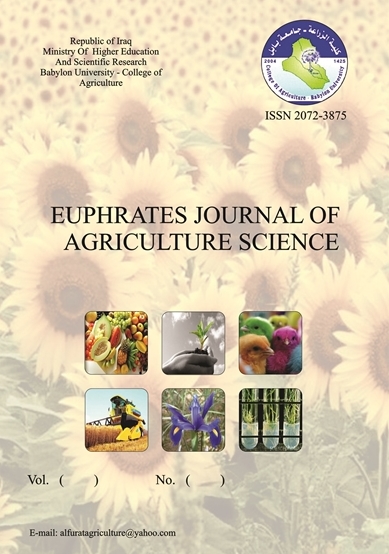Abstract
Antioxidants are used to reduce the impact of environmental stresses on plant growth, especially salt stress because they have an effect on reducing the oxidative stress resulting from effective oxygen radicals inside the plant in response to environmental stresses on the plant. Therefore, the study was conducted in Al-Hilla district, Al-Hakania region for the period from (1\9\2020 - 1\5\2021) to investigate the effect of salt stress on the vegetative and root traits of Pomelo seedlings treated with saline water (0, 2, 4, 6 dSm. m-1) using sodium chloride salt,The second factor is spraying the seedlings (salicylic, ascorbic, proline) at a concentration of 300 mg.L-1 in addition to the (control ) treatment at the end of the experiment, the vegetative traits were measured (total chlorophyll pigment in leaves, dry weight of the shoot, number of branches) ) and root traits (dry weight of the root system, number of secondary roots).The results showed the treatment with salicylic acid at a concentration of 300 mg.l-1 excelled in all the studied traits, and proline acid at a concentration of 300 mg.L-1 recorded a significantly excelled in the root traits. The study was designed as a factorial experiment according toThe Randomized Complete Block Design (RCBD) and with three replications with three seedlings for the experimental unit and with two factors (4 * 4), the number of the experiment’s treatments was (16) treatments distributed randomly to (144) seedlings of one and a half years of age, The results were analyzed using the analysis of variance table (ANOVA table) according to the EXCEL program, and the statistical differences between the treatments were tested using the least significant difference L.S.D at the probability level (0.05), and the most important results can be summarized as follows:
1. Increasing the salinity levels of irrigation water to the level of 6 ds.m-1 (S3) led to a decrease in all vegetative and root growth traits(number of branches, vegetative dry weight, chlorophyll pigment, root dry weight, number of secondary roots), reaching (4.7 branches.plant-1, 29.2 g. seedling-1, 59.1 mg g-1 fresh weight, 16.4 g seedling-1, 21.3 root) for the traits, respectively.
2. Treatment with salicylic acid, ascorbic or proline, resulted in a concentration of 300 mg. L-1 improves vegetative and root growth indicators by reducing the effect of salinity of irrigation water in varying percentage ,Salicylic acid (A3) achieved greater effectiveness in improving the traits of vegetative and root growth (number of branches, dry weight of vegetative, total chlorophyll, dry weight of the root system and number of secondary roots), reaching (7.1 branches. plant-1, 40.1 g. seedling-1, 72.9 mg g-1 fresh weight, 21.6 g seedlings-1, 28.2 roots) for the traits, respectively.
